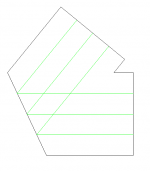Calculated again at 2m distance (seems the previous sim was not in far-field enough).
Horizontal, vertical, diagonal:



The dimensions are 624 x 448 x 328 mm (W x H x D).
Horizontal, vertical, diagonal:
The dimensions are 624 x 448 x 328 mm (W x H x D).
The mouth radius of a horn like in #10238 (DS8-T12?) will be very difficult to bend without siping or steaming even using plywood as thin as 4mm.If you started like this with a square mouth that is made from Flexi-ply and a laser cutter (cheap and very easy!- this would take 30seconds machine time)
Those that cannot access a laser can draw out the coordinates on the wood manually
You would have to check/be careful of the max Bend radius, (looks ok by my guess)
Multiple layers to reach around 12mm thickness are required to keep the wood non resonant.
We are talking about this - https://www.aresca.it/multiflex-the-flexible-and-bending-plywood/#.YrcXOuzP0uU
Couldn't be easier. Of course more than one layer may be required.

Couldn't be easier. Of course more than one layer may be required.
The ply is a special type with a rubber middle layer and vineers on both sides that run in the same direction. The stuff can be rolled into approximately 200mm ring without signs of cracking.The mouth radius of a horn like in #10238 (DS8-T12?) will be very difficult to bend without siping or steaming even using plywood as thin as 4mm.
Multiple layers to reach around 12mm thickness are required to keep the wood non resonant.
All plywood is bendable, but I'd never seen plywood with the fibers all aligned in 1 direction before, thanks for the link.We are talking about this - https://www.aresca.it/multiflex-the-flexible-and-bending-plywood/#.YrcXOuzP0uU
Couldn't be easier. Of course more than one layer may be required.
Definitely opens up construction not possible with standard plywood!
Greetings all,
before I go and re-read the entire 513 pages long thread, would anyone recall whether mabat posted a script or *.stl file for either the ATH-CE460-0 or the ATH-CE360-0?
Kindest regards,
M
before I go and re-read the entire 513 pages long thread, would anyone recall whether mabat posted a script or *.stl file for either the ATH-CE460-0 or the ATH-CE360-0?
Kindest regards,
M
The petal version of the CE360 is here
https://www.diyaudio.com/community/...-design-the-easy-way-ath4.338806/post-6794755
https://www.diyaudio.com/community/...-design-the-easy-way-ath4.338806/post-6794755
so obviously bandwidth is AMAZING. but its really not as smooth as your axisymmetrical designs. do you think it would be clearly audible? wouldn't the best still be a large axisymmetric? Are you just weighing up the ease of construction here? For good engineering always need to balance these two ofc. are you hoping do listening tests against your large old ones?...can be as good as this (480 mm mouth size / 1.5" throat):
I am, of course. But at the same time it was a sort of a revelation that the shape itself doesn't cause any problems regarding smoothness - see #10,175 where it was in an infinite baffle (the intuition just doesn't work here). It's all about termination.Are you just weighing up the ease of construction here?
As for the audibility, my guess is that this already approaches a threshold where it doesn't make a clear difference.
Last edited:
- Of course axisymmetric is still the "purest" form of the device, but if made (e.g.) an octagon I now think one could get quite close to the overall radiation pattern and smoothness - with the advantage that it will be pretty easy (with the flexi plywood) to make it any size desired.
I wonder if a pentagon or perhaps a heptagon (7) would have an advantage in its absence of parallel walls?
//
//
As I already have rectangle I can easily modify the code to make 8 or 6-sided polygons just by shifting the position of the corner point, still preserving the 1/4 symmetry. For anything else I would have tp rewrite much of the code and I'm not sure it's worth the effort - the are actually no parallel walls even for a rectangle. Yes, it's symmetric, but that's a circle too (far more symmetric) and it works fine.
Yes but then the circle should be the worst of all shapes and we know already that a round waveguide can be made virtually perfect.
You could argue that for a circle, only a extremely small surface (infinity small) has an opposing parallel surface - no? 🙂
//
//
You're reading too much into parallel surfaces here. Not only aren't they an issue in this case, if they were going to be it could still happen without the parallel surfaces.
No, there are no "opposing parallel surfaces" in any horn (except where there actually ARE parallel surfaces 🙂 )You could argue that for a circle, only a extremely small surface (infinity small) has an opposing parallel surface - no? 🙂
//
It can be symmetric though and then round is the most symmetric shape you can think of.
- Home
- Loudspeakers
- Multi-Way
- Acoustic Horn Design – The Easy Way (Ath4)
